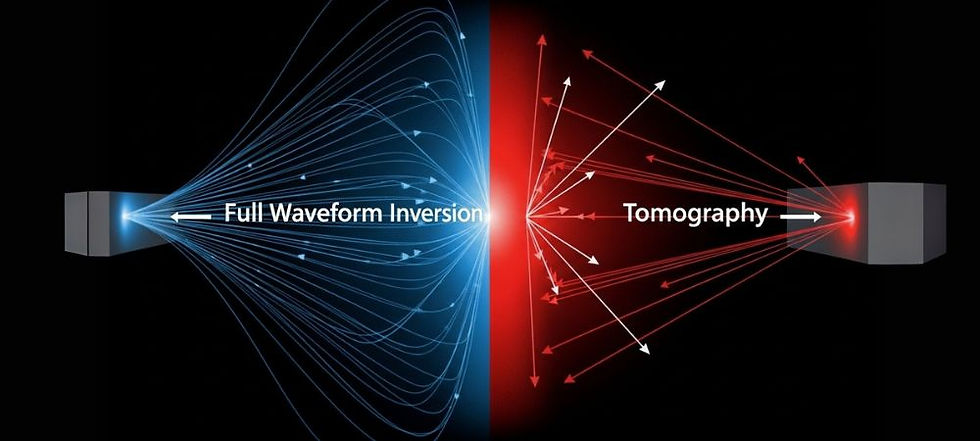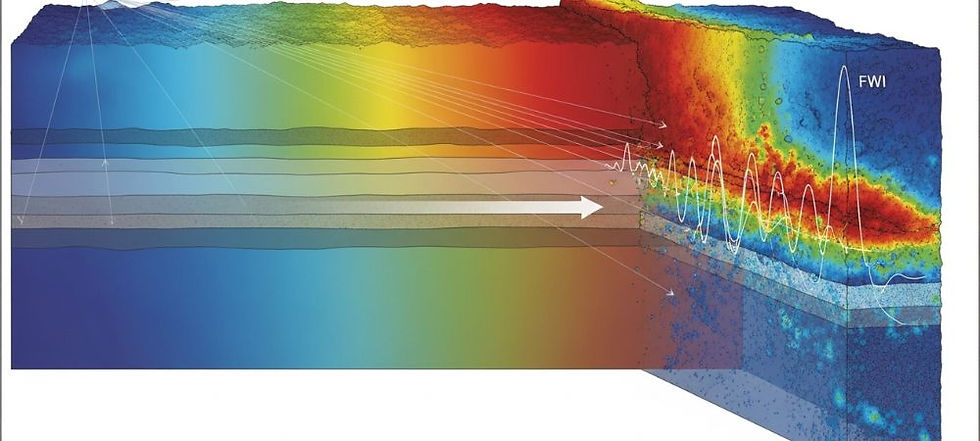FWI vs. Tomography: Is FWI Just a Fancy Version of Tomography?
- abid riaz
- Aug 27
- 6 min read
Updated: Aug 28
Introduction
When we compare FWI vs. tomography, it’s easy to wonder: Is full-waveform inversion simply a more advanced form of tomography? After all, both of these methods aim to improve Seismic velocity modelling and enhance Subsurface imaging resolution. But in reality, these two techniques are fundamentally different in the way they work and what they reveal.
This article will dissect those differences clearly and will explore the role of Ray tracing vs. wave propagation, explaining how these methods handle data, and which tool works best depending on your seismic challenges.
The Short Answer: Why FWI is More Than Just Tomography
While it’s tempting to think of FWI as just a "fancier" tomography, this isn’t the reality. Although they are related, they are based on very different scientific foundations. FWI is a major advancement that allows for much more detailed seismic models.
A Quick Definition: What is Travel-Time Tomography?

Travel-time tomography uses the concept of ray theory to trace the paths seismic waves take through the Earth. It measures the time taken for waves to arrive at sensors and utilises this information to estimate how fast they traveled through different layers.
This approach is relatively simple and efficient. It builds smooth velocity models that are able to provide a general understanding of the subsurface but lack fine details.
A Quick Definition: What is Full-Waveform Inversion (FWI)?
FWI not only uses the travel times but also uses the complete seismic signal. This method models the entire wavefield using the wave equation, capturing wave reflections, diffractions, and all other wave phenomena. Through matching the recorded and simulated waveforms, FWI refines velocity models to a much higher resolution. You can learn more about FWI and its work through our Ultimate Guide to Full-Waveform Inversion (FWI).
The Core Difference: Ray Theory vs. Wave Equation
How Tomography Works: Following the Fastest Path
Tomography approximates wave propagation as rays that travel along the shortest time paths. Think of it like GPS navigation; it focuses mainly on the quickest routes without considering how the waves actually bend or scatter.
How FWI Works: Iterative Inversion of the Full Wavefield
FWI considers the full physics of wave movement, including how waves bend, scatter, and change amplitude and phase. This allows for a far more detailed picture of subsurface structures.
What Tomography Misses: Amplitudes, Phases, and Scattered Energy
By focusing mainly on travel times, tomography ignores critical information like wave amplitudes and phases. These contain clues about rock properties and small-scale structures that FWI can reveal.
Head-to-Head Comparison: FWI vs. Tomography

Resolution and Detail: Broad Sketch vs. Fine Brushstrokes
Tomography and Full-Waveform Inversion (FWI) produce vastly different levels of detail in subsurface imaging. Tomography generates broad, smoothed velocity models that are effective for outlining large-scale structures but often miss the finer nuances of the geology. For example, tomography may show the general shape of a salt dome or the extent of a sedimentary basin, but it tends to blur small-scale features such as thin layering, narrow faults, or subtle stratigraphic traps. FWI, in contrast, produces high-resolution, fine-scale velocity models that capture these subtle details with remarkable clarity.
By leveraging the full seismic wavefield, FWI can highlight features such as small channel systems or thin carbonate layers that are invisible in tomography results. In oil and gas exploration, this difference can determine whether an operator simply identifies a salt body or can actually see the potential reservoir hidden beneath it.
Physics and Data Usage: First Arrivals vs. the Full Story
The two methods also differ significantly in the physics they rely on and the data they use. Tomography primarily depends on seismic travel times—measuring how quickly the first-arriving waves move through the subsurface. This approach captures broad velocity contrasts but discards much of the recorded seismic information, such as later arrivals, reflections, and diffractions. As a result, tomography is somewhat limited in its ability to constrain complex velocity structures.
FWI, on the other hand, uses the entire seismic waveform, which includes not only travel times but also amplitudes, phases, and frequency content. This richer dataset allows FWI to model wave propagation more realistically, providing a much more geologically accurate picture. A useful analogy is comparing a black-and-white line drawing to a high-definition photograph: tomography gives you the outlines, while FWI fills in the texture and detail.
Geological Complexity: Where Tomography Struggles and FWI Shines
The strengths and weaknesses of each method become especially clear in geologically complex settings. Tomography often struggles in areas where seismic waves are distorted, such as beneath salt canopies, basalt flows, or regions with strong lateral variations in rock properties. For example, in the Gulf of Mexico, tomography often produces blurred or inaccurate images beneath salt layers, making it difficult to position wells confidently.
FWI, however, thrives in these environments because it models the full physics of wave propagation, including refractions, diffractions, and multiples. This allows FWI to reconstruct sharper and more reliable subsurface images, even in challenging conditions. As a result, FWI has become a preferred technique in regions with complex geology, where conventional tomography would otherwise leave critical gaps in understanding.
Computational Cost: Speed and Efficiency vs. Power and Precision
One of the main trade-offs between tomography and FWI lies in their computational requirements. Tomography is relatively inexpensive to run and can generate a usable velocity model in a short period of time, making it suitable for early-stage reconnaissance work or when computational resources are limited. This efficiency makes it attractive for projects where speed and cost control are more important than resolution.
In contrast, FWI is extremely computationally demanding. Because it involves solving the full wave equation iteratively for massive datasets, FWI requires high-performance computing systems and significant processing time. Depending on survey size and geological complexity, FWI projects can take days or even weeks to complete. While this added cost is a limitation, many operators consider it worthwhile for high-priority exploration areas where the accuracy of the imaging directly impacts drilling success and investment decisions.
At a Glance: Comparison Table
Feature | Travel-Time Tomography | Full-Waveform Inversion (FWI) |
Underlying Physics | Ray Theory | Wave Equation |
Data Used | Travel Times | Full Seismic Waveform |
Resolution | Low to Medium | High to Very High |
Best Use Case | Building initial velocity models | High-resolution modelling in complex geology |
Computational Cost | Low | High |
Are They Competitors or Partners? The Modern Workflow
Why Tomography is Still Essential: Building the Initial FWI Model
Despite all of FWI’s advantages, tomography remains crucial for creating initial velocity models. These smooth models help guide the FWI process and prevent it from getting stuck in inaccurate solutions.
How They Work Together: Using Tomography to Constrain FWI

The modern approach more often involves running tomography first, then refining the model with FWI. This workflow combines the strengths of both techniques.
The Result: A More Robust and Accurate Final Velocity Model
Using tomography and FWI together results in a more reliable, detailed subsurface image, which is ideal for challenging geology and critical decision-making.
When Should You Choose FWI Over Tomography?
When High-Resolution is Critical for Reservoir Characterization
When your project requires detecting small faults, fractures, or thin layers, FWI’s high resolution is essential.
For Imaging Complex Sub-Salt or Carbonate Environments
Areas with salt bodies, carbonate formations, or complicated layering benefit greatly from FWI’s wave-based approach.
When You Need to Understand Shallow Hazards in Detail
For identifying near-surface features and hazards before drilling, FWI provides the detail that tomography cannot.
Making the Right Choice with EIFGeosolutions
Our Expertise in Both Tomography and Advanced FWI
Building an accurate velocity model is the most critical step in seismic imaging. Don't guess which method is right for your project. The experts at EIFGeosolutions specialize in designing optimal velocity model building workflows, from tomography to advanced FWI, tailored to your unique geological challenges. Contact us to ensure your project is built on a flawless foundation.
We Help You Build the Optimal Velocity Modelling Workflow
Our team helps design workflows that combine tomography and FWI effectively to maximize your subsurface insights. If you are interested in improving your seismic data processing and building the most accurate velocity models, we can be of help.
Conclusion
So, is FWI just a fancy version of tomography? Not at all. FWI represents a significant leap forward, using full waveforms to create detailed and accurate models where tomography falls short.
However, tomography remains an important first step. Together, they are able to form a powerful seismic velocity modelling workflow.
Choosing the right approach depends on your project’s complexity, resolution needs, and computing resources.
FAQs
Q: Can FWI replace tomography completely?
A: No. Tomography often provides the starting model needed for FWI to work effectively.
Q: When is travel-time tomography preferred?
A: For building initial, smooth velocity models where fast results are needed.
Q: How does FWI achieve higher resolution?
A: By using the entire seismic waveform, including amplitude and phase information.
Q: What are the main limitations of ray-based tomography?
A: It struggles with complex geology and ignores important waveform data.
Q: How does migration differ from tomography?
A: Migration images reflectors, while tomography builds the velocity model used for imaging.


Comments